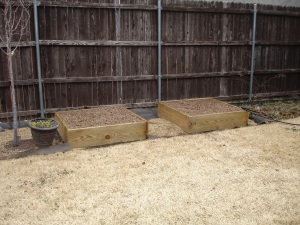I found a vermiculite supplier so I'm now ready to mix the soil. For those of you not familiar with square foot gardening, the suggested growing medium is 1/3 peat moss, 1/3 course vermiculite, and 1/3 a mix of at least three kids of compost. For those in the DFW area - you can get the course Vermiculite from Marshall Grain and Feed Company. They have a store in Ft. Worth and a store near the DFW airport. I bought all the other components at my local big box hardware store (which refused to order course vermiculite for me). By far the most expensive component is the vermiculite which ran about $22 per bag but it never degrades and once you've paid for it once, you should never have to buy it again.
Here is what all the packaged soil components looked like for my four 4X4X1 gardens:

I decided to mix approximately 2 cubic feet of each component (peat, vermiculite and compost) in each batch.
On the first mixing attempt, I laid each component next to each other on a tarp like this:

I then lifted the tarp back and forth from each corner trying to mix it. This was a really hard way to mix.
Here is what it looked like after mixing:

For the next batch, I piled each component on top of each other with the driest ingredients on the bottom. I put the vermiculite on the bottom since it was the driest material and the easiest to distinguish to make sure it was mixed through. Like this:

I then got on my hands and knees and mixed it by hand. This was much easier than moving the tarp back and forth.
After each batch, I pulled the tarp over to the garden and emptied it into the garden.
This is what one of the gardens looked like after the two batches (this means one 4cu ft. bag of Vermiculite, one 2.2 cu ft bag of compressed peat moss, one 2 cu foot bag of regular compost, one (approx.) 1 cu foot bag of mushroom compost and one (approx.) 1 cu foot bag of composed cow manure):

This is what two of the gardens looked like after all of the materials were used up:

The amount I had purchased for the four gardens was just shy of perfect. Each garden was full to about 1/2 in. from the brim. When it rained the next day, however, each of the gardens settled about an inch. I brought in some more compost to bring them up to level with the top.










